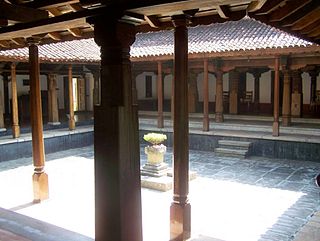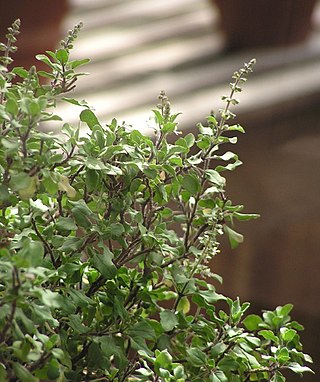Related Research Articles

Lakshmi, also known as Shri, is one of the principal goddesses in Hinduism, revered as the goddess of wealth, fortune, prosperity, beauty, fertility, royal power and abundance. She along with Parvati and Sarasvati, forms the trinity called the Tridevi.

Avatar is a concept within Hinduism that in Sanskrit literally means 'descent'. It signifies the material appearance or incarnation of a powerful deity, or spirit on Earth. The relative verb to "alight, to make one's appearance" is sometimes used to refer to any guru or revered human being.

Odia is a classical Indo-Aryan language spoken in the Indian state of Odisha. It is the official language in Odisha, where native speakers make up 82% of the population, and it is also spoken in parts of West Bengal, Jharkhand, Andhra Pradesh and Chhattisgarh. Odia is one of the many official languages of India; it is the official language of Odisha and the second official language of Jharkhand. The Odia language has various varieties, including the Baleswari Odia, Central Odia, Ganjami Odia, Sundargadi Odia, Sambalpuri, Desia and Tribal Community dialects who have adopted the Odia language.

Jagannatha is a deity worshipped in regional Hindu traditions in India as part of a triad along with his (Krishna's) brother Balabhadra, and sister, Subhadra. Jagannath, within Odia Hinduism, is the supreme god, Purushottama, and the Para Brahman. To most Vaishnava Hindus, particularly the Krishnaites, Jagannath is a form of Krishna, sometimes as the avatar of Vishnu. To some Shaiva and Shakta Hindus, he is a symmetry-filled tantric form of Bhairava, a fierce manifestation of Shiva associated with annihilation.

Shaktism is a major Hindu denomination in which the godhead or metaphysical reality is considered metaphorically to be a woman.

Revati is a goddess featured in Hindu scriptures. She is King Kakudmi's daughter and Krishna's elder brother Balarama's consort, and also one of the Dashavatara. Her account is given within a number of Hindu texts such as the Mahabharata and the Bhagavata Purana.

Sarala Dasa was a 15th-century poet and scholar of Odia literature. Best known for three Odia books — Sarala Mahabharata, Vilanka Ramayana and Chandi Purana — he was the first scholar to write in Odia and his revered as the Adi Kabi of Odia literature. As an originator of Odia literature, his work has formed an enduring source of information for succeeding generations.

The Maa Sarala Temple is a Hindu temple in the district of Jagatsinghpur, Odisha, India. It is one of the eight most famous Shakta shrines of Odisha.
Odia literature is literature written in the Odia language, mostly from the Indian state of Odisha. The modern Odia language is mostly formed from Tadbhava words with significant Sanskrit (Tatsama) influences, along with loanwords from Desaja, English, Hindustani (Hindi/Urdu), Persian, and Arabic. Its earliest written texts date from around 1000 CE. The earliest Odia newspaper was Utkala Deepika, first published on August 4, 1866.

MahapurusaAchyutananda Dasa (Odia:-ଅଚ୍ୟୁତାନନ୍ଦ ଦାସ ) was a 16th-century poet seer and Vaishnava saint from Odisha, India. He was considered to have the power to see the past, present and future. He was a prolific author, and one of the group of five, that led a revolution in spirituality in Odisha by translating Sanskrit texts into the Odia language for common people.

Lakshmi Puja or Lokkhi Pujo is a Hindu occasion for the veneration of Lakshmi, the Goddess of Prosperity and the Supreme Goddess of Vaishnavism. The occasion is celebrated on the amavasya in the Vikram Samvat Hindu calendar month of Ashwayuja or Kartika, on the third day of Deepavali (Tihar) in most parts of India and Nepal. In Odisha, Assam, Bengal this puja is celebrated five days after Vijaya Dashami.

The Biraja Temple, or Birija Kshetra, is a historic Hindu temple located in Jajpur, Odisha, India. The present temple was built during the 13th century. The principal idol is Devi Durga, who is worshipped as Viraja (Girija), and the temple gave Jajpur the nicknames "Viraja Kshetra" and "Biraja Peetha". The Durga idol has two hands (dwibhuja), spearing the chest of Mahishasura with one hand and pulling his tail with the other. One of her feet is on a lion, and the other is on Mahishasura's chest. Mahishasura is depicted as a water buffalo. The idol's crown features Ganesha, a crescent moon and a lingam. The temple covers a large area, and has several shrines to Shiva and other deities. According to the Skanda Purana it cleanses pilgrims, and it is called the Viraja or the Biraja kshetra. Jajpur is believed to have about one crore of Shiva lingams.

Devī is the Sanskrit word for 'goddess'; the masculine form is deva. Devi and deva mean 'heavenly, divine, anything of excellence', and are also gender-specific terms for a deity in Hinduism.

A Tulasi Vrindavana is a small podium-like stone or cement altar present in front of traditional Hindu houses, housing the sacred tulasi plant. Tulasi is an aromatic plant in the family Lamiaceae, native throughout the tropics, and widespread as a cultivated plant and an escaped weed.

The Vimala Temple or Bimala Temple is a Hindu temple dedicated to goddess Vimala or Bimala (ବିମଳା), located within the Jagannath Temple complex in Puri in the Indian state of Odisha. It is generally regarded as a Shakta pitha, among the holiest temples dedicated to the Hindu Goddess.

Tulasi, Tulsi or Vrinda is a sacred plant in Hindu tradition. Hindus regard it as an earthly manifestation of the goddess Tulasi; she is regarded as the avatar of Lakshmi, and thus the consort of the god Vishnu. In another iteration, as Vrinda, she is married to Jalandhara. The offering of its leaves is recommended in ritualistic worship of Vishnu and his avatars, like Krishna and Vithoba.

Jagannatha Dasa, known by the honorific Atibadi, meaning "very great", was an Odia poet and litterateur. He was one of the five great poets in Odia literature, known as the Panchasakha. He wrote the Odia Bhagavata Purana (Bhagabata).

Mānabasā Gurubāra is a festival celebrated by Odia Hindus in the East Indian state of Odisha. It is also celebrated by Odias living in Andhra Pradesh, Chhattisgarh, South Jharkhand and South West Bengal. In this festival Goddess Mahalaxmi is the presiding deity. It is believed by the people that the goddess herself comes to every household and removes pain and sorrow. It is held on every Thursday in the month of Margasira.
The Jagamohana Ramayana also known as the Dandi Ramayana popularly across Odisha is an epic poem composed by the 15th-century poet Balarama Dasa. This work is a retelling of the Ramayana, though not a direct translation.

Balarama Dasa was an Odia poet and litterateur. He was one of the 5 great poets in Odia literature, the Panchasakha named Sri Ananta Dasa, Sri Jagannatha Dasa, Sri Jasobanta Dasa and Sri Achyutananda Dasa during the Bhakti age of literature. He was the eldest of the Pancha sakha. He wrote the Jagamohana Ramayana also known as Dandi Ramayana.
References
- ↑ Mansingha, Mayadhar (1962) History of Odia literature Sahitya Akademi, New Delhi,
- ↑ T. N. Padmavati; A. S. Venugopal; Hari; T. N. Prabhakar; T. N. Saraswati; T. R. Krishnamurthy; Vidwan M. N.; Lakshminarasimha Bhatta (23 March 2019). Epic Characters of Puranas. Bharatha Samskruthi Prakashana. ISBN 978-93-89028-75-1.
- ↑ Research Anthology on Religious Impacts on Society. IGI Global. 21 July 2020. ISBN 978-1-7998-3436-6.
- ↑ Orissa Society of Americas 41st Annual Convention Souvenir: For Annual Convention Held in 2010 at San Francisco, California. Odisha Society of the Americas.
- ↑ Research Anthology on Religious Impacts on Society. IGI Global. 21 July 2020. ISBN 978-1-7998-3436-6.
- ↑ Orissa Society of Americas 41st Annual Convention Souvenir: For Annual Convention Held in 2010 at San Francisco, California. Odisha Society of the Americas.
- ↑ Varadpande, Manohar Laxman (2009). Mythology of Vishnu and His Incarnations. Gyan Publishing House. ISBN 978-81-212-1016-4.
- ↑ Dāsa, Baḷarāma (2007). Lakshmi Purana: A Paean to the Goddess of Fortune. Grassroots. ISBN 978-81-89040-28-4.